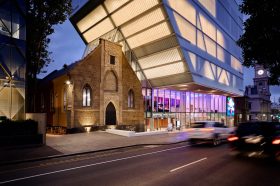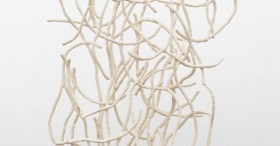Paola Balla, photographed as Mok Mok, will talk matriarchy, healing and story at Yirramboi
In 1994, Simon and Schuster published The Psychology of Hope by Professor Charles Richard Snyder. Throughout his career, Snyder published six books and 262 articles about Hope Theory and the impact hope can have on all aspects of our lives.
Snyder argues that there are three main things that make up hopeful thinking:
- Goals – Approaching life in a goal-oriented way
- Pathways – Finding different ways to achieve our goals
- Agency – Believing that we can instigate change and achieve these goals
In The Psychology of Hope, which grew out of his own 15-year struggle with chronic pain, he explores two aspects concerning our ability to shape our own futures:
- Will Power – the will to shape our own future, and
- Way Power – our ability to see ways to shape the future
He explains why a normally positive person can feel confused if they feel depressed when facing a particular challenge. They still have a strong will to solve the issue, but cannot see a way to find a solution. However, once they see a way through the problem, the cloud evaporates and their sense of hope returns, feeling reinvigorated to tackle the challenge. We all know the saying, “Where there’s a will, there’s a way.” But this phrase can be turned around to say, “Where there’s a way, there’s a will.”
Snyder also analyzes the significant events our first 18 years of life contribute to the development of hope. Through a variety of clinical cases, he explores how hope is often destroyed in children and in adults. He shows how neglect, abuse, parental loss, unrealistic expectations for the child, and inconsistent parenting can erode in different ways the child’s ability to envision goals or their ability to develop strategies to reach them.
Now, if we, just for a second, substitute the words ‘child’ and ‘parenting’ for ‘artist’ and ‘administration’, we get a fairly clear and concise summary of the chaos the arts community, as a whole, is facing today. For the Indigenous arts sector, there is a lot to be (potentially) less hopeful about.
I met the opportunity to take on the role of Creative Director of the then Melbourne Indigenous Arts Festival with an equal measure of excitement and terror. This new role posed challenges – namely, raising the profile of Indigenous arts and culture, inspiring participation, challenging perceptions and developing the next generation of Indigenous arts practitioners. It is more than just a role, it is a responsibility.
To play a role, with contractual obligations and clauses, to me implies that one can hand over, delegate down, even opt out. A responsibility, however, ups the stakes. It requires of you to hold space and to take action.
Did I have a goal? Many. Could I identify pathways toward achieving those goals? I wasn’t sure, but I had a budget. Did I believe I had the agency to achieve, for my community and myself, the hopes and dreams I held for our sector? At first, this wasn’t clear either, but I had a vision of our future and the will to fight for it. I just needed to find the way.
I’d inherited a consortia model that consisted of mostly non-Indigenous organisations, without Indigenous representation within their companies, or a commitment to Indigenous arts as part of their core business.
A model whereby potential presenting partners were of the assumption that they, knowing their audiences and in protecting their brand, bound by board rooms and bottom lines, would feed this first time Festival Director lists of shows and ideas and I, as the good novice, would curate these into one cohesive thread under the guise of an Indigenous arts festival.
And when I looked at the list of shows I’d been asked to consider, what I’d been given was a collection of serious, spiritual storytelling with lots of dots and, you guessed it, didgeridoos. This just wasn’t gonna work.
After many frustrated and failed attempts at early negotiations, a bold and potentially risky move needed to be made. A vision became a philosophy and a philosophy became a framework. A framework, which delivered a set of four non-negotiable curatorial principles, that hopefully we could all be guided by:
- Indigenous Leadership – ensuring that every production, exhibition, concert and idea must have Indigenous creative as the lead. That each event be conceived, choreographed, curated, written and directed by First Nations talent, placing First Nations authority and decision making first.
- Visibility and Dialogue – seek out, provide and support new platforms and contexts for presentation, whilst simultaneously and rigorously creating space for new language and dialogue to emerge around how we perceive and talk about Indigenous contemporary arts.
- New work and Ideas – supporting artists to present work, at any stage of development, that seeks to go beyond acceptable narratives and comfortable known outcomes. Not as a matter of innovation, but integrity. Supporting artists bringing 60,000 plus years of performance making dramaturgies and methodologies to the fore of their practice and process, rather than performed cultures on stage.
- Collaboration and exchange – to create and facilitate a gathering space that not only promotes exchange between our mob and First Nations internationally, but encourages contemporary arts exchange and collaboration, nation to nation within our country
Still a little shaky in my new shoes, I again hit the pavement, this time with a will and a way. But would they go for it?
I wasn’t just pitching programming choices this time. I was suggesting that together we not so much reinvent the wheel, but at least change it. For as we know, the wheel is broken, the cart it fell off is now best used as firewood and the horse pulling the cart, is practically dead, poor thing.
And it has been through an act of hope that a will and a way forward has been paved by the collective efforts of our dedicated team at YIRRAMBOI, the City of Melbourne, Creative Victoria and all our presenting partners. Sure, we lost a few along the way, whether it be from fear of the unknown, a matter of bad timing or a clash of ideology – some of us like things just as they are. And that’s ok, because it created space for new allies to emerge.
Our responsibility as curators, presenters and programmers of arts venues and of festivals, is to facilitate space: for the individual and collective voice. Indeed, this is the responsibility of all arts organisations – to pave the way for expression and facilitate the civic engagement of new voices. These may not always be voices we agree with, at first.
But unless they are given the opportunity to be hear – on their own terms, in their own language, or form, experimentation or discipline/s – we lose the chance to experience those moments when a singular voice becomes the will and the vision of the collective. This, as a curator or presenter, requires courage, hope and a fearless embracing of risk – because it makes anything possible, and allows any voice to be heard.
The Yirramboi First Nations Arts Festival will run in Melbourne from 5 to 14 May 2017.
This article is an excerpt from a Currency House Creativity and Business Breakfast Address on Wednesday, 8 March 2017 at the Museum of Contemporary Art, Sydney





